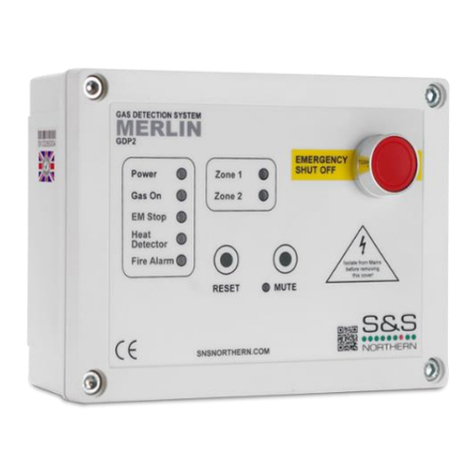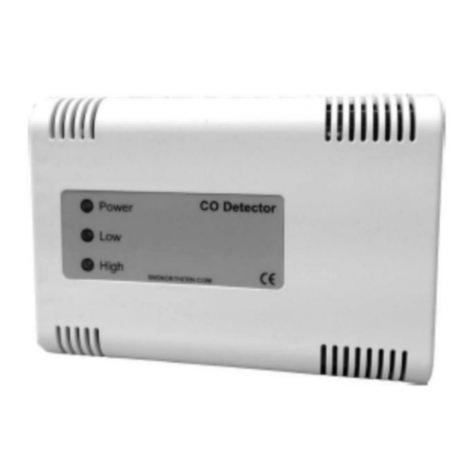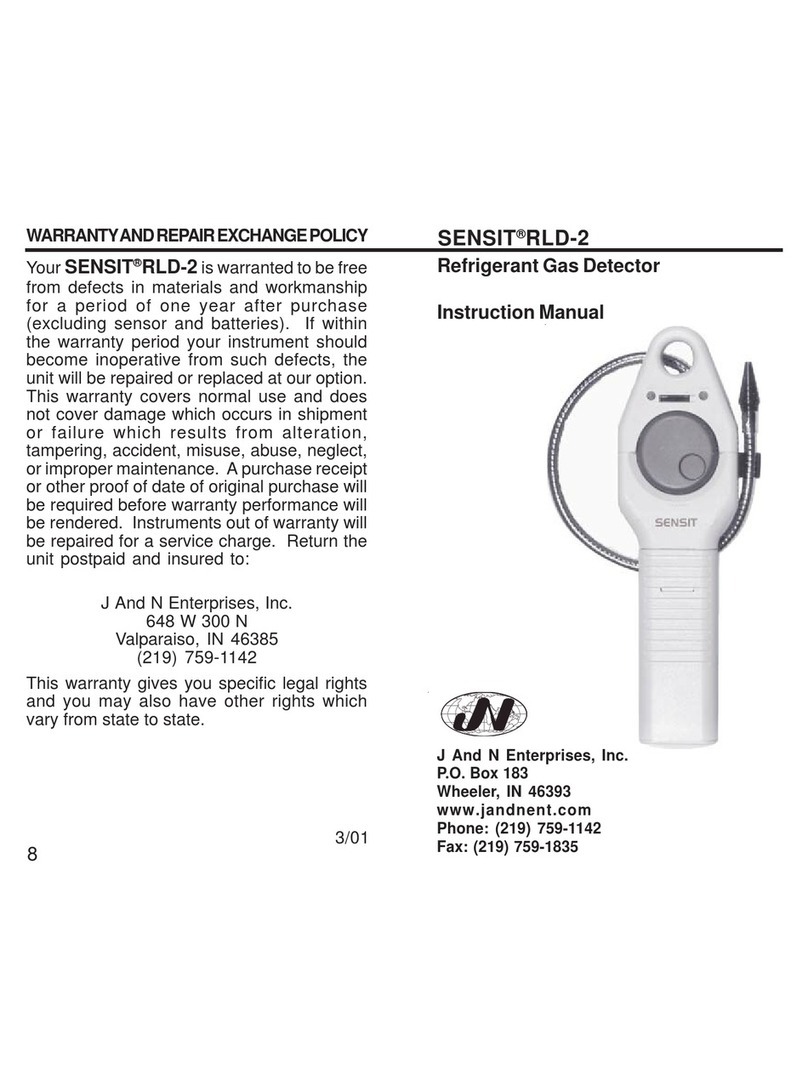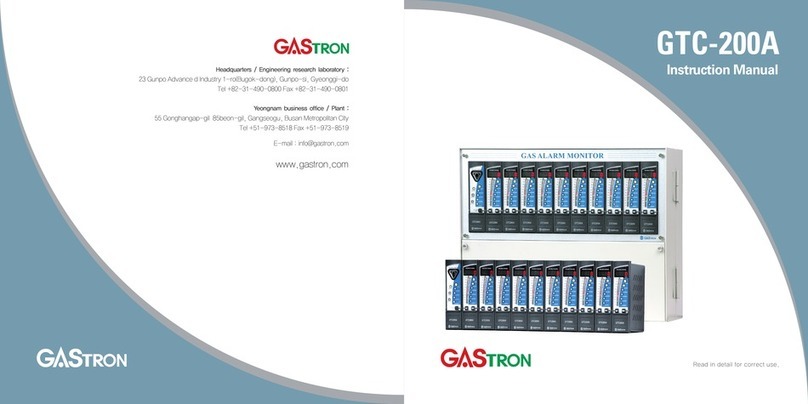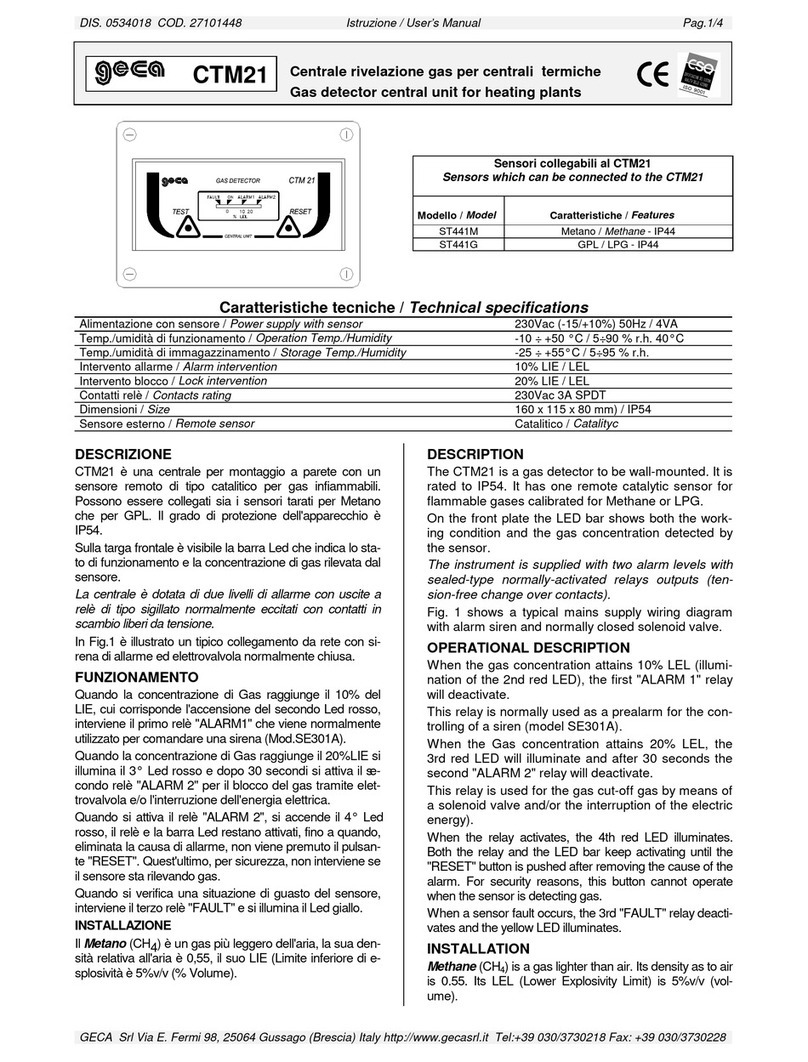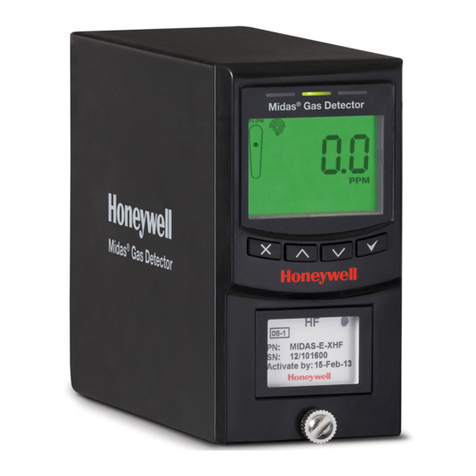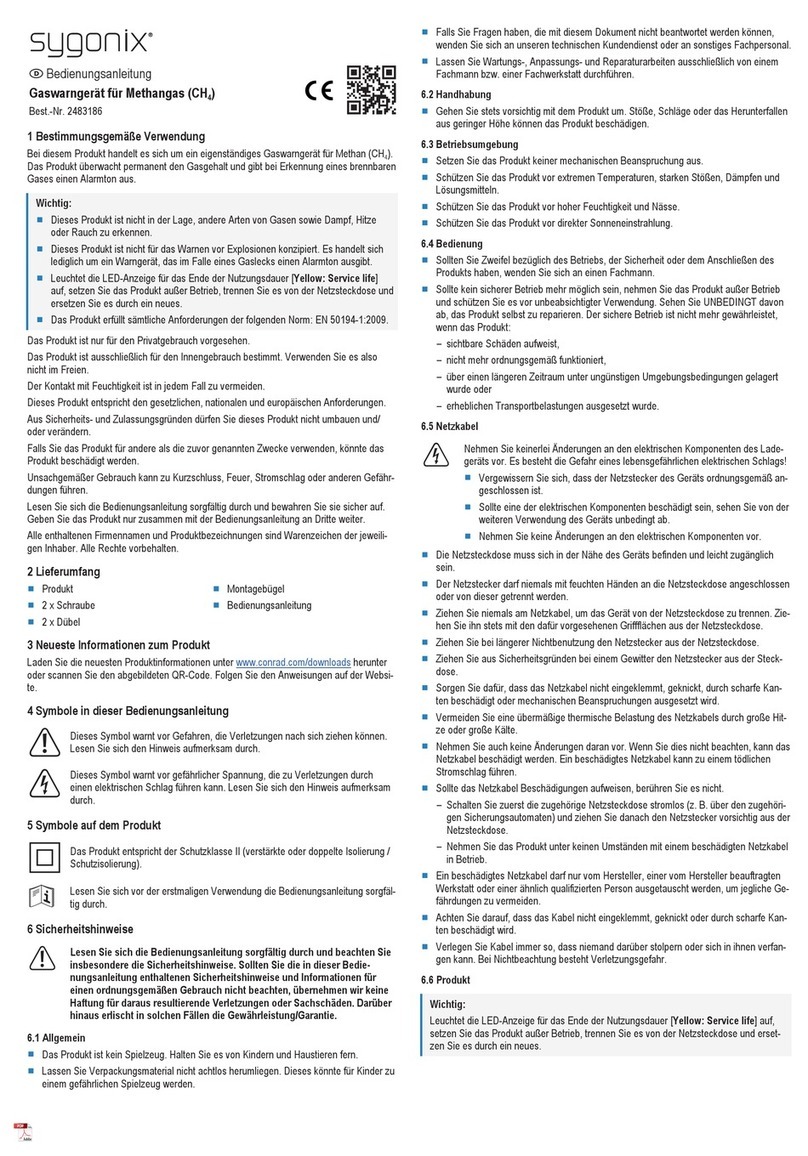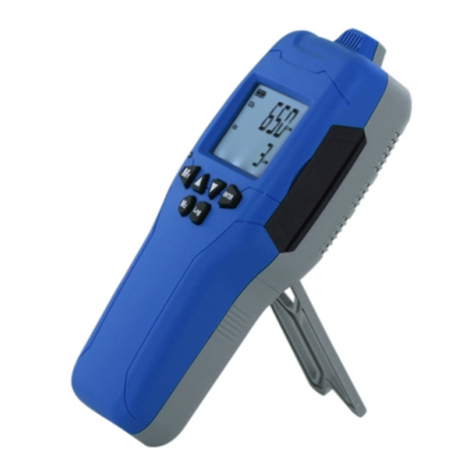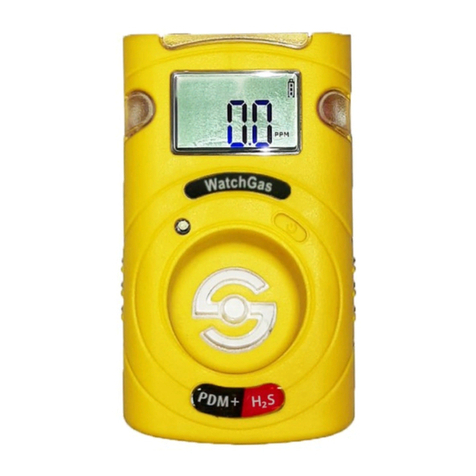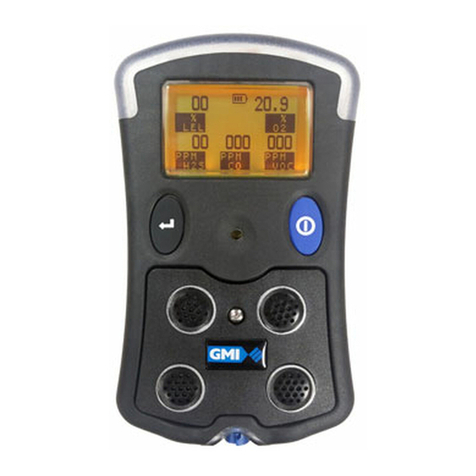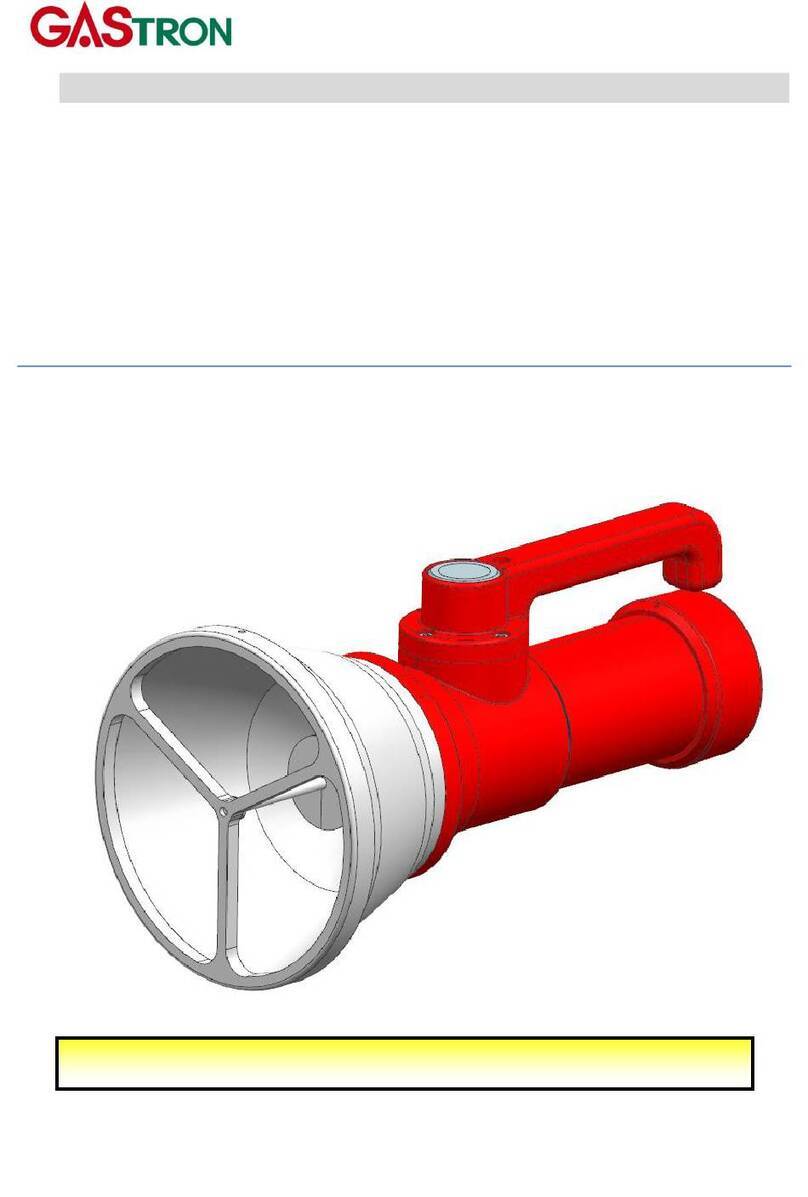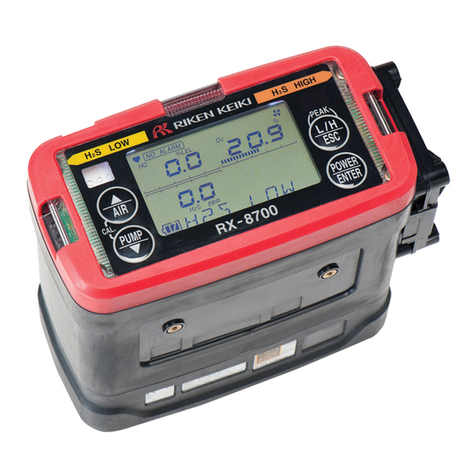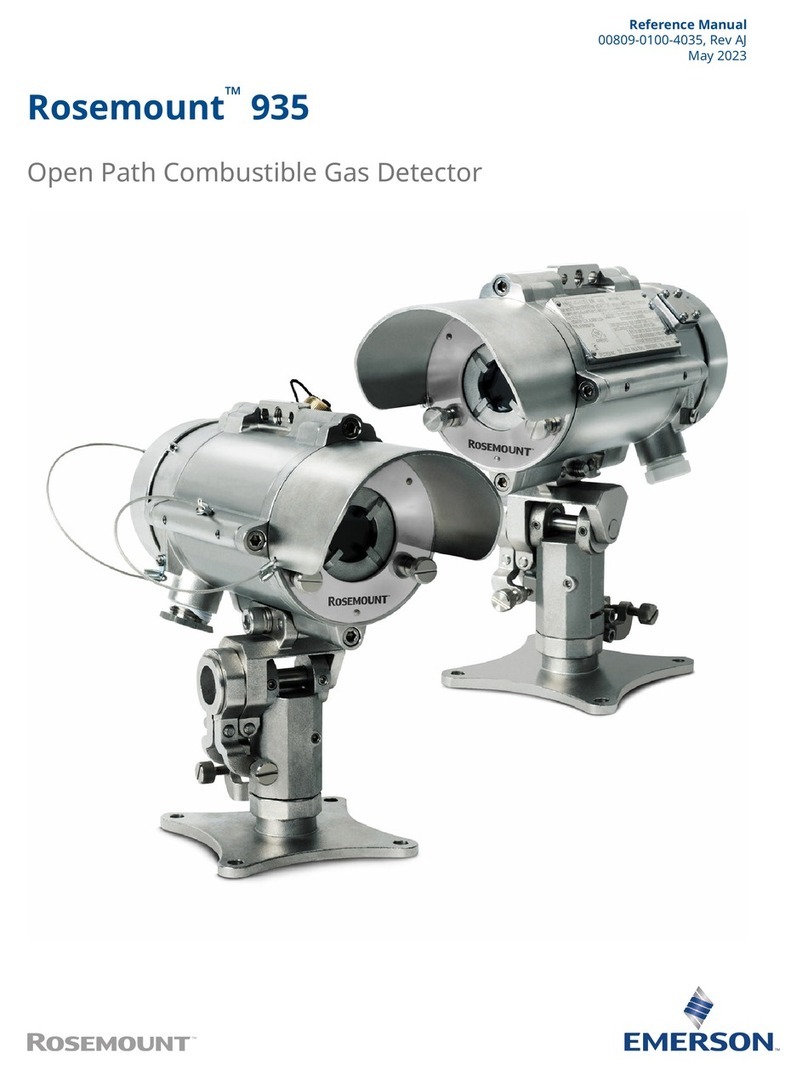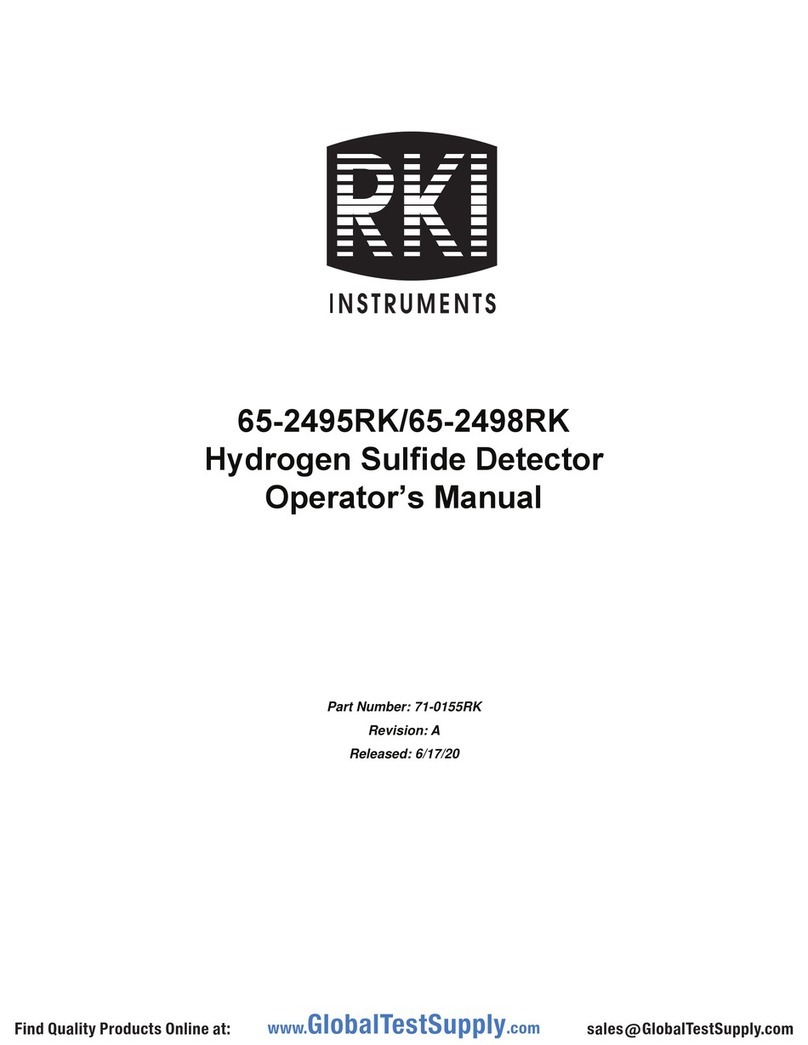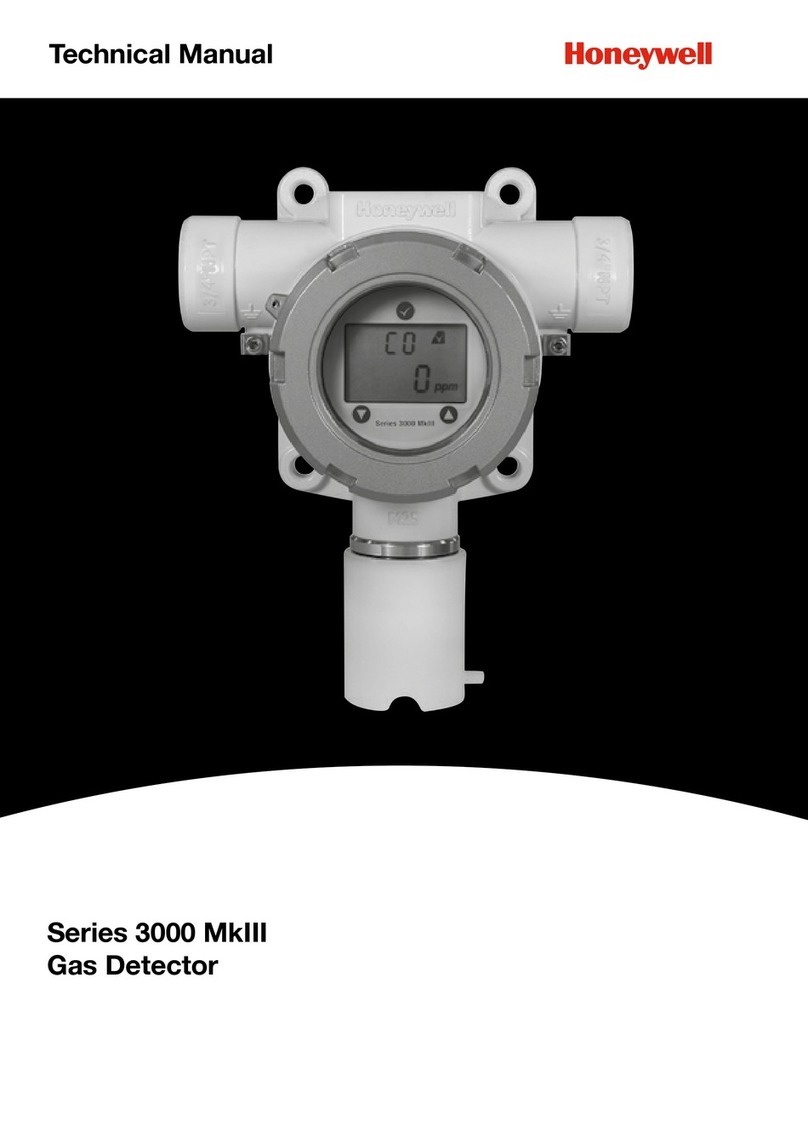S&S Northern Merlin Detector i-S Owner's manual

Installation, Operation & Maintenance Manual Merlin Detector i-S
Iss: 1 170322 1
Merlin Gas Detector i-S
Installation, Operation & Maintenance
Please read this manual carefully and retain for future use.
For specific requirements that may deviate from the information in this guide –contact your supplier.
S&S Northern Limited
www.snsnorthern.com

Installation, Operation & Maintenance Manual Merlin Detector i-S
Iss: 1 170322 2
Contents
Important Warning Statements..............................................................3
Installation...............................................................................................4
Typical Application & Location .......................................................................................4
Mounting & Cabling .........................................................................................................5
Circuit Board Overview ...................................................................................................6
Wiring: Power Input..........................................................................................................6
Wiring: Alarm Relays........................................................................................................7
Alarm Relay Setting Switch –Latch On/Off..................................................................7
Wiring: 0-10V Analogue Output .....................................................................................7
CO2Selection Switches ..................................................................................................7
Audible Buzzer Switch.....................................................................................................8
Factory Set Condition......................................................................................................8
Operation ................................................................................................8
Initial Power Up.................................................................................................................8
Latched Relay Alarm........................................................................................................8
Alarm Set Points...............................................................................................................9
Maintenance ...........................................................................................9
Cleaning ............................................................................................................................9
Manual Circuit Simulation Test ......................................................................................9
Bump Test (Gas Response Check) ...............................................................................9
Bump Test Procedure ...................................................................................................10
End of Operational Life (EOL) ......................................................................................10
Specification .........................................................................................11

Installation, Operation & Maintenance Manual Merlin Detector i-S
Iss: 1 170322 3
Important Warning Statements
Please take the time to thoroughly read these instructions which should be retained for future reference.
Detectors are shipped pre-calibrated and configured.
The expected lifetime of a gas sensor is 3-10 years upon initial power up dependant on your target gas and environmental
factors. The device will display a message to indicate this time and should immediately be replaced.
It is recommended that this device be commissioned upon installation and serviced annually by a competent person.
Do not apply lighter gas or other aerosols to the device –this will cause extreme damage to the sensors.
High concentrations of alcohol found in many products may damage, deteriorate, or affect the gas sensing elements.
This product is not designed to detect smoke, fire or other gases and should not be used as such.
This device provides early warning of the presence of gas, usually before a healthy adult would experience symptoms. This
warning is possible provided your alarm is installed and maintained in accordance with this manual.
Never ignore your device when in alarm.
This device requires a continual supply of electrical power –it will not work without power.
This device should not be used to substitute proper installation, use and/or maintenance of fuel burning appliances
including appropriate ventilation and exhaust systems.
Multiple detectors may be required to adequately protect property and persons.
This device does not prevent dangerous gasses from occurring or accumulating.
The device is not intended for use in potentially explosive atmospheres.
Seek fresh air supply and contact your local gas emergency service should you suspect a gas leak.
This unit may not fully safeguard individuals with specific medical conditions. If in doubt, consult a doctor/physician.
Your product should reach you in perfect condition, if you suspect it is damaged, contact your supplier.
Concentrations of alcohol found in many products may damage, deteriorate or affect the gas sensing elements such as;
wine; deodorants; stain removers and thinners. Other gases and substances to avoid are corrosives (i.e. chlorine &
hydrogen chloride); alkali metals; basic or acidic compounds; silicones; tetraethyl lead; halogens and halogenated
compounds!
Manufacturer’s Warranty
Warranty coverage: The manufacturer warrants to the original consumer purchaser, that this product will be free of defects in
material and workmanship for a period of three (3) years from date of purchase or one (1) year for oxygen detectors.
The manufacturer’s liability hereunder is limited to replacement of the product with repaired product at the discretion of the
manufacturer. This warranty is void if the product has been damaged by accident, unreasonable use, neglect, tampering or other
causes not arising from defects in material or workmanship. This warranty extends to the original consumer purchaser of the
product only.
Warranty disclaimers: Any implied warranties arising out of this sale, including but not limited to the implied warranties of
description, merchantability and intended operational purpose, are limited in duration to the above warranty period. In no event shall
the manufacturer be liable for loss of use of this product or for any indirect, special, incidental, or consequential damages, or costs,
or expenses incurred by the consumer or any other user of this product, whether due to a breach of contract, negligence, strict
liability in tort or otherwise. The manufacturer shall have no liability for any personal injury, property damage or any special,
incidental, contingent or consequential damage of any kind resulting from gas leakage, fire, or explosion. This warranty does not
affect your statutory rights.
Warranty Performance: During the above warranty period, your product will be replaced with a comparable product if the defective
product is returned together with proof of purchase date. The replacement product will be in warranty for the remainder of the
original warranty period or for six months –whichever is the greatest.
Information on waste disposal for consumers of electrical & electronic equipment.
When this product has reached the end of its life it must be treated as Waste Electrical & Electronics Equipment (WEEE). Any WEEE
marked products must not be mixed with general household waste, but kept separate for the treatment, recovery and recycling of the
materials used. Please contact your supplier or local authority for details of recycling schemes in your area.
At the end of their working life, electrochemical sensors should be disposed of in an environmentally safe manner.
Alternatively, they can be securely packaged and returned to S&S Northern clearly marked for disposal. Electrochemical
sensors should not be incinerated as this may cause the cell to emit toxic fumes.

Installation, Operation & Maintenance Manual Merlin Detector i-S
Iss: 1 170322 4
Installation
Typical Application & Location
Installation must be carried out by a licenced, insured contractor!
Ensure that detectors are not exposed to liquid or dust contamination!
Detectors and cables must be protected against mechanical damage!
Avoid conditions of any other environmental factors outside of the specification that could potentially impede the accuracy
and operation of the detector such as condensation; vibration; temperature, pressure, the presence of other gases,
electromagnetic interference, and draft zones!
The target gas will only be identified when contact is made with the sensing element itself!
Gas detectors should be installed in areas at risk of gas leaks e.g., near boilers, valves, or meters, located in positions
determined by those who have knowledge of gas dispersion, the process plant system and equipment involved, and
in consultation with both safety and electrical engineering personnel.
Take in to account the design of the air flow patterns within the area. Detectors should be installed in the correct
orientation, as recommended, and ease of access should be accounted for to allow for any bump tests and other
forms of maintenance throughout its operating life.
There are no official figures of the area coverage of a gas detector; however, 50m2per detector is a reasonable
general guide therefore multiple detectors may be required to adequately protect property and persons.
There are no specific standards governing gas detector location (unlike fire detection systems); there are, however,
general guidance documents. The most relevant being IEC 60079-29-2: Explosive Atmospheres –Part 29: Gas
detectors –Selection, installation, use and maintenance of detectors for flammable gases and oxygen. Much of what it
covers is also relevant to toxic gas detection.
Recommended heights may vary based on air flow and temperature conditions in addition to the proposed application
and location. Locations for detectors will vary based on the intended application and target gas, they should be
located near identified sources of a potential gas leaks/pockets where gas could quickly accumulate and areas of
identified consequential risk to detect gas. The composition of the target gas and its density relative to air are used as
the basis for the recommended height of sensors. Generally, the installation height of a sensor for a heavy gas (such
as propane) would be close to the lowest point in the area, and for a light gas (such as methane) would be close to
the highest point in the area.
These typical positions may vary based on air flow and temperature conditions in addition to the proposed application
and location –this is particularly apparent with oxygen depletion sensors, and the target gas that they are used for.
Target Gas
Typical Position
Natural Gas/Methane (NG)
High Level - 300mm (1ft) from ceiling
Liquid Petroleum Gas (LPG)
Low Level - 300mm (1ft) from ground level
Carbon Monoxide (CO)
Breathing Zone - 1700mm (5ft 6”) from ground level
Carbon Dioxide (CO2)
Breathing Zone - 1700mm (5ft 6”) from ground level
Hydrogen (H)
High Level - 300mm (1ft) from ceiling
Nitrogen Dioxide (NO2)
Low Level - 300mm (1ft) from ground level.
Oxygen (O2)
*Breathing Zone - 1000-1500mm (3 - 5ft) from ground level
* If you are installing and monitoring oxygen depletion monitors –consider the density of gas for its application and
position the detector accordingly i.e., ground level for high density gases.
Detectors should be mounted where a potential hazard of gas is most likely to be present. The following points should
be noted also when locating gas sensors. When locating detectors consider
•The possible damage caused by natural events e.g., rain or flooding.
•Ease of access to the gas detector for functional testing and servicing.
•How gas may behave due to natural or forced air currents.

Installation, Operation & Maintenance Manual Merlin Detector i-S
Iss: 1 170322 5
Mounting & Cabling
If mounting direct to wall - ensure the wall surface is flat to prevent base distortion!
Ensure the rear base is installed in the correct orientation as shown!
Where cable glands/conduits are used for wire entry, use 20mm (3/4 inch) max separated by at least 20mm!
Any parts that form part of the connections/installation must have a minimum fire-retardant rating of UL94v-2!
Damage to PCBs when creating cable entry points or attempting to remove the circuit board may void any warranty!
The monitor is designed for either surface mounting or mounted on a one or two gang electrical box.
Restrain the hazardous live wiring from accidental loosening to prevent wires from moving after installation and touching
parts of opposite polarity or at low voltages!
Isolate the equipment from all hazardous live power sources before opening the cover!
1. Carefully remove the front cover from the unit by using an M3 socket wrench.
2. Using the rear base - mark mounting holes to the wall or align with an appropriate gang/pattress box.
3. Fixing straight to wall –drill 0.2” (5mm) hole, insert plugs and use the four screws (No.4 Pozi) provided.
4. There are pre-fractured areas for cable entry on the rear of the base and pilot holes positioned on the top and bottom
of the enclosure suitable for entry points up to ¾” (20mm).
5. After executing the mounting/connections –secure the front cover with all M4 bolts and insert security caps provided.

Installation, Operation & Maintenance Manual Merlin Detector i-S
Iss: 1 170322 6
Circuit Board Overview
Damage to PCBs when creating cable entry points may void any warranty!
Any damage attempting to remove the circuit board may void any warranty!
Wiring: Power Input
Standalone Power
12-24V power inputs can be either AC or DC.
Terminals are pluggable type to ease connections.
Merlin GDP Power Connection
Power is supplied via the GDP terminal [+ / -].
Use the [C/L] terminal as an alarm relay.
Wire in parallel for multiple detectors.
Merlin Proving Panel Power Connection
Power is supplied via the 24VDC terminal [+ / -].
Use the open/close terminal as an alarm relay to detectors.

Installation, Operation & Maintenance Manual Merlin Detector i-S
Iss: 1 170322 7
Wiring: Alarm Relays
These are volt free connections to a BMS (building management systems) or Merlin panel to send an alarm signal
upon pre/alarm levels of gas. Max 1A load @ 12/24V DC or AC.
If you are connecting detector(s) via a GDP panel you will need to use the [C/L] terminal as an alarm relay. A relay will
change state when in alarm or pre-alarm when gas is detected and if wired/configured to do so.
These terminals can be used in conjunction with other external relays that affect other devices and controls such as
purge fans and audible alarms etc.
Alarm Relay Setting Switch –Latch On/Off
It is recommended to leave the alarm relay setting switch on, particularly for flammable detectors!
The switch is left on as a factory set condition!
This switch is used to latch/unlatch an alarm relay.
When turned on the Detector relay will latch permanently on (until Reset) in the event of the detector detecting gas
and entering an alarm state.
The detector will indicate a red dot on the screen when the alarm relay has latched.
The alarm will beep every 10 seconds to alert the user that the detector entered an alarm state.
To reset the Detector, press and hold the touch button for ~3 seconds.
Wiring: 0-10V Analogue Output
This connection is used to regulate external fan speed controllers (supplied separately). Connect direct to fan speed
controllers or via your Merlin panel [0-10V] terminal if available. 0-10V output is driven by the status of gas
concentrations detected.
0-10 Volt Output Range
Gas & Measurement
1V
2V
3V
4V
5V
6V
7V
8V
9V
10V
NG/CH4Methane: %LEL
1%
2%
3%
4%
5%
6%
7%
8%
9%
10%
LPG Propane: %LEL
H2Hydrogen: %LEL
CO Carbon Monoxide: ppm
30
60
90
120
150
180
210
240
270
300
See section: CO2 Selection Switches
CO2 0-5000ppm Range
Carbon Dioxide: ppm
500
1000
1500
2000
2500
3000
3500
4000
4500
5000
CO20-2000ppm Range
Carbon Dioxide: ppm
200
400
600
800
1000
1200
1400
1600
1800
2000
CO2Selection Switches
These switches configure alarm thresholds of CO2(carbon dioxide) only.
There is a legend on the board for quick reference.
X = OFF / O = ON
S1
S2
Pre-Alarm
Alarm
S3
0-10V Output Range
O
O
2800ppm
4500ppm
O
0 - 5000ppm
X
O
1500ppm
2800ppm
O
X
1200ppm
1500ppm
X
0 - 2000ppm (Default)
X
X
800ppm (Default)
1000ppm (Default)

Installation, Operation & Maintenance Manual Merlin Detector i-S
Iss: 1 170322 8
Audible Buzzer Switch
There is a switch on the detector board identified as [Buzzer On/Off].
The detector can be configured to have an audible alarm or not when gas levels reach the alarm set points. The alarm
will continuously sound –there are no provisions to silence the alarm, gas levels must drop to a safe value for the
alarm to stop.
Factory Set Condition
Detectors are shipped pre-calibrated and configured.
Buzzer On/Off Switch
On
Alarm Relay Setting Switch
On
CO2 Selection
Pre-Alarm (800ppm) / Alarm (1000ppm) / 0-2000ppm 0-10V Output Range
Operation
Initial Power Up
On connecting power, the detector enters a warmup phase for approximately 60 seconds –during this period, your
device not yet ready for operation.
OK Pre-Alarm Alarm
Latched Relay Alarm
The detector will indicate a red dot on the screen when the alarm relay has latched.
The alarm buzzer will beep every 10 seconds to alert the user that the detector entered an
alarm state. To reset the Detector, press and hold the touch button for ~3 seconds.

Installation, Operation & Maintenance Manual Merlin Detector i-S
Iss: 1 170322 9
Alarm Set Points
An audible buzzer will sound if the buzzer switch on the circuit board is on!
CO2alarm levels stated are factory set condition only!
Target Gas
Pre-Alarm
Buzzer
Alarm
Buzzer
Methane/Natural Gas (NG)
▲8% LEL
No Sound
▲ 10% LEL
Continuous
sound
Liquid Petroleum Gas (LPG)
▲8% LEL
▲10% LEL
Hydrogen Gas (H2)
▲8% LEL
▲10% LEL
Oxygen (O2)
▼19.5%
▼18.5% or ▲23%
Carbon Monoxide (CO)
▲ 20 ppm
▲ 20ppm after two (2) hours
▲50ppm after One (1) hour
▲100ppm after Ten (10) minutes
▲ 300ppm after One (1) minute
*Carbon Dioxide (CO2)
▲800 ppm
▲1000 ppm
3 beeps every
10 seconds
▲Rising alarm ▼Falling alarm
(LEL) Lower Explosive Limit (PPM) Parts Per Million
* CO2alarm levels stated are factory set condition only.
Maintenance
Cleaning
Concentrations of alcohol found in many products may damage, deteriorate or affect the gas sensing elements such as;
wine; deodorants; stain removers and thinners. Other gases and substances to avoid are corrosives (i.e., chlorine &
hydrogen chloride); alkali metals; basic or acidic compounds; silicones; tetraethyl lead; halogens and halogenated
compounds!
Keep your gas detector in good working order - follow these basic principles.
•Remove any dust/debris from the outer enclosure regularly using a slightly damp cloth.
•Never use detergents or solvents to clean your device.
•Never spray air fresheners, hair spray, paint or other aerosols near the device.
•Never paint the device. Paint will seal vents and interfere with the device.
Manual Circuit Simulation Test
Access to the interior of the detector, when carrying out any work, must be conducted by a competent person!
This circuit test does not check the gas-sensing element itself!
When the test button on the circuit board is pressed and held for ~3seconds the detector will simulate an open circuit
to ensure configured systems, outputs, alarms, indications, and other external devices operate as intended in
response to gas. The test sequence will automatically terminate after a short period of time and return to normal
operation.
Bump Test (Gas Response Check)
What is a Bump Test?
Gas response checks are often referred to as a ‘bump test’. Bump tests are important to make sure a device can
detect a release of gas as early as possible. The aim of the bump test is to make sure a detector is working at its
optimum by briefly exposing the unit to a known concentration of the target gas that usually exceeds the highest
alarm point. If the detector goes into alarm and all signals/outputs activate, then the system is working safely.
If the system fails to operate as intended in an alarm state, the gas detector must not be used until a full inspection
and service has been conducted.

Installation, Operation & Maintenance Manual Merlin Detector i-S
Iss: 1 170322 10
Why is it important?
A detector may visually appear in good working order, but its sensitivity and accuracy can be inhibited by external
factors. Dust, humidity, temperature fluctuations, cleaning products, contaminants, exposure to its target gas or
sensor drift (ageing) can cause a decline in sensitivity, accuracy, and eventual failure.
How often?
Regular bump tests are important to make sure the detector can detect a release of gas as early as possible and
usually takes seconds (gas type dependant i.e., CO sensors will take over a minute) and is often completed alongside
a scheduled fire alarm test, however the frequency should be determined following an appropriate risk assessment by
the end user. We recommend testing detectors every 12-18 months along with the regular fire test procedures and
coincide with the annual service message prompted on the detection system after each year of service/operation.
What do I need?
Contact your S&S representative for details of suitable bump testing kits and gases. Kits usually consist of a certified
gas cylinder or spray. We recommend only using S&S calibration gas kits to ensure correct flow rates meet S&S
technical requirements. A bump testing gas is usually a concentration mix that exceeds the highest alarm set point.
Bump Test Procedure
To increase reaction time, cover the escape vents at the sides of the device.
Always remove the regulator/valve if using a cylinder after use!
Always give at least five (5) minutes between testing the same unit or until gas has fully dispersed!
Always consider safety and use equipment in accordance with Safety Data Sheets!
Reference should always be given to any applicable national & local law and industry codes.
Generally, the gas concentration should be greater than the alarm threshold of the device.
Always remove the regulator/valve after use if using a cylinder!
All cylinders will re-seal upon removal of the regulator/valve!
Deviating from this test process is deemed improper and may affect the functional safety of your device!
Exposure to chemicals, smoke, or any other materials other than the gases intended to be monitored can seriously damage
the gas sensing elements!
Always allow a minimum of 5 minutes before testing the same unit!
1. Ensure you have the correct gas for the device type prior to application.
2. Offer up the applicator hose/cone or spray and apply to the small vents of the device located underneath.
3. Apply gas.
4. The device will enter alarm status after reaching alarm set point.
5. The device will activate all configured outputs/relays.
At this point…
6. Remove applicator hose/ cone or spray.
7. Reset by pressing the touch sensor.
8. Test complete.
9. Record your test details.
End of Operational Life (EOL)
The EOL is approximate from the first five (5) hours of continuous power!
The EOL will depend on the type of gas your detector is targeting and may vary depending on its application and
environmental conditions such as the frequency of exposure to the target gas, poisons, or inhibitors!
The typical life of a gas detector depends on its application and intended target gas, in addition the
operational life can be prolonged if the system and equipment is installed and maintained in accordance
the instructions stated within this manual. At the end of its predicted operational life –the detector will display an ‘End
of Life’ screen. This message indicates that the detector has reached its expected operational lifecycle and no gas
levels are displayed. You must contact your supplier immediately for replacement.

Installation, Operation & Maintenance Manual Merlin Detector i-S
Iss: 1 170322 11
Specification
General
Model:
Detector i-S
Target Gases:
NG / LPG / CO / CO2/ O2/ H2/
Size: (H x W x D)
5.95 x 4.37 x 1.97” (151 x 111 x 50mm)
Housing Material:
ABS PA765. Flame Retardant UL 94V-1
Mounting:
Safe Zone - Indoor use - Wall Mounted
Weight:
212g
User Interface
Display:
1.8” TFT
Screen Brightness:
Non-Adjustable
Visual Indicators:
Gas Level (Green: Normal; Yellow: Pre-Alarm; Red: Alarm) 0-10V Output: Relay Output
Audible Alarm:
>65dB @ 3.28ft (1m). Quiet conditions.
Language:
English
Power Supply
Max. Power Consumption:
CO21.45W
NG/LPG/H21.8W
CO 0.6W
Power Rating:
12-24V AC or DC
Relays
Volt Free BMS relay outputs:
1A switching current (resistive load) @ 24V AC/DC
Environmental
Ingress Protection (IP):
Not Formally Evaluated
Operating:
-10 ~ 50°C / 20 ~ 90% RH (non-condensing)
Storage:
0 ~ 50°C / 30 - 80% RH (no condensation)
Altitude Rating:
2000m
Wiring
Typical
Min. 2.5mm2 / 75°C min / Tinned copper.
Approvals
Electrical Safety and Electromagnetic
Compatibility
BS EN 61010-1:2010 +A1:2019.
BS EN 50270.
Sensor Specification
Gas Sensor
Measuring
Range
Steps
Response
(t90)
Recovery
(t10)
Pre-Alarm:
Alarm:
*EOL
(Years)
Electrochemical Sensors
Carbon Monoxide (CO)
0-999ppm
1
<60s
<60s
▲20ppm
Exposure time.
▲20ppm (after two hours)
▲50ppm (after one hour)
▲100ppm (after ten minutes)
▲300ppm (after one minute)
5
Oxygen (O2)
0-25%
0.1
<60s
<60s
▼19.5%
▼18.5% or ▲23%
2
Semiconductor Sensors
Methane (CH4) NG
0-20% LEL
0.1
<30s
<30s
▲8% LEL
▲10% LEL
10
Propane (LPG)
0-20% LEL
0.1
<30s
<30s
▲8% LEL
▲10% LEL
10
Hydrogen (H2)
0-20% LEL
0.1
<30s
<30s
▲8% LEL
▲10% LEL
10
NDIR. Intelligent Infrared CO2 Module. ABC Logic Auto Calibration
Carbon Dioxide (CO2)
(Default Setting)
0-5000ppm
1
<50s
<60s
▲800ppm
▲1000ppm
10
▲Rising Alarm ▼Falling alarm / *EOL –Expected Operational Life

Installation, Operation & Maintenance Manual Merlin Detector i-S
Iss: 1 170322 12
Installation Details
Please pass this manual to the system owner / user.
Date of Installation:
Installation Location:
Organisation:
Stamp/Signature of the installer:
We recommend all Merlin gas detection equipment be commissioned by competent/trained engineers to ensure
correct installation and operation. The Merlin range of gas detectors are calibrated when manufactured, however, we
strongly recommend the detectors response and alarm signals are tested and validated once installed. This will
ensure the equipment performs as intended and is free from any unforeseen damage caused by transit/installation.
Every effort is made to ensure the accuracy of this document; however, S&S Northern can assume no responsibility for any
errors or omissions in this document or their consequences. S&S Northern would greatly appreciate being informed of any
errors or omissions that may be found in the content of this document. For information not covered in this document, or if
there is a requirement to send comments/corrections, please contact S&S Northern using the contact details given below.
S&S Northern Limited
www.snsnorthern.com
S&S Northern Head Office
Tel: +44(0) 1257 470 983
Email: info@snsnorthern.com
Southeast Division
Tel: +44(0) 1702 291 725
Email: south@snsnorthern.com
S&S Northern is the owner of this document and reserves all rights of modification without prior notice.
Table of contents
Other S&S Northern Gas Detector manuals
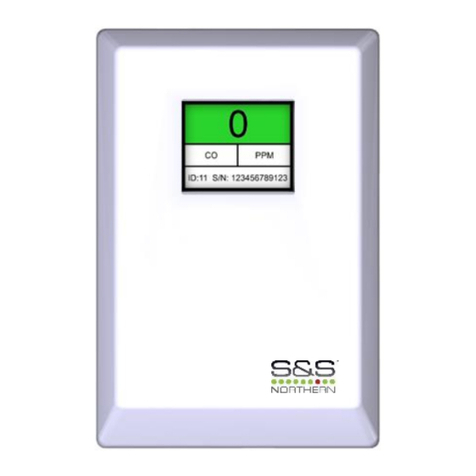
S&S Northern
S&S Northern MERLIN CO DETECTOR X Owner's manual
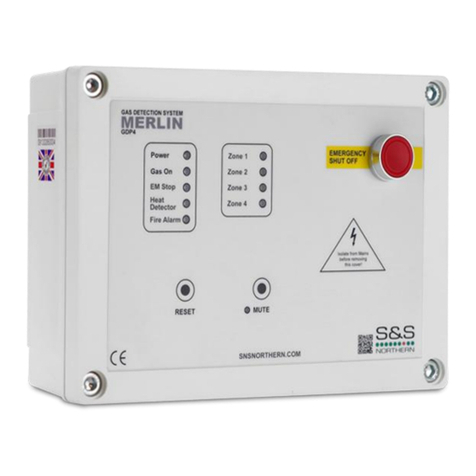
S&S Northern
S&S Northern Merlin GDP4 User manual

S&S Northern
S&S Northern MERLIN GDPX+ User manual
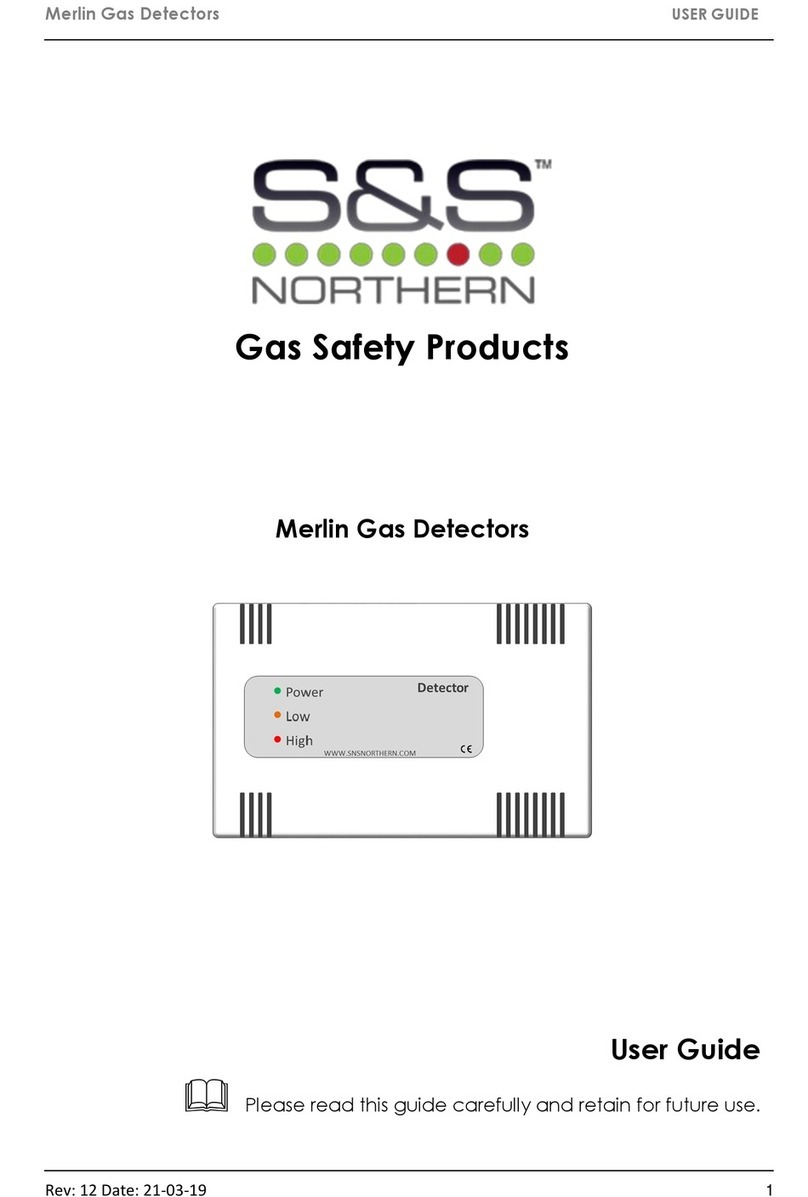
S&S Northern
S&S Northern Merlin User manual

S&S Northern
S&S Northern Merlin GDP4 Owner's manual

S&S Northern
S&S Northern Merlin 1000BH Owner's manual
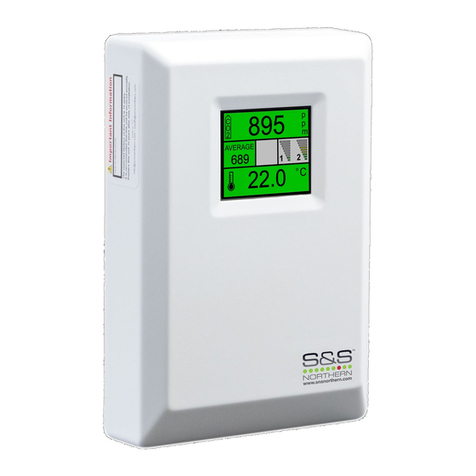
S&S Northern
S&S Northern MERLIN CO2-X Instruction manual

S&S Northern
S&S Northern Merlin 1000BH User manual
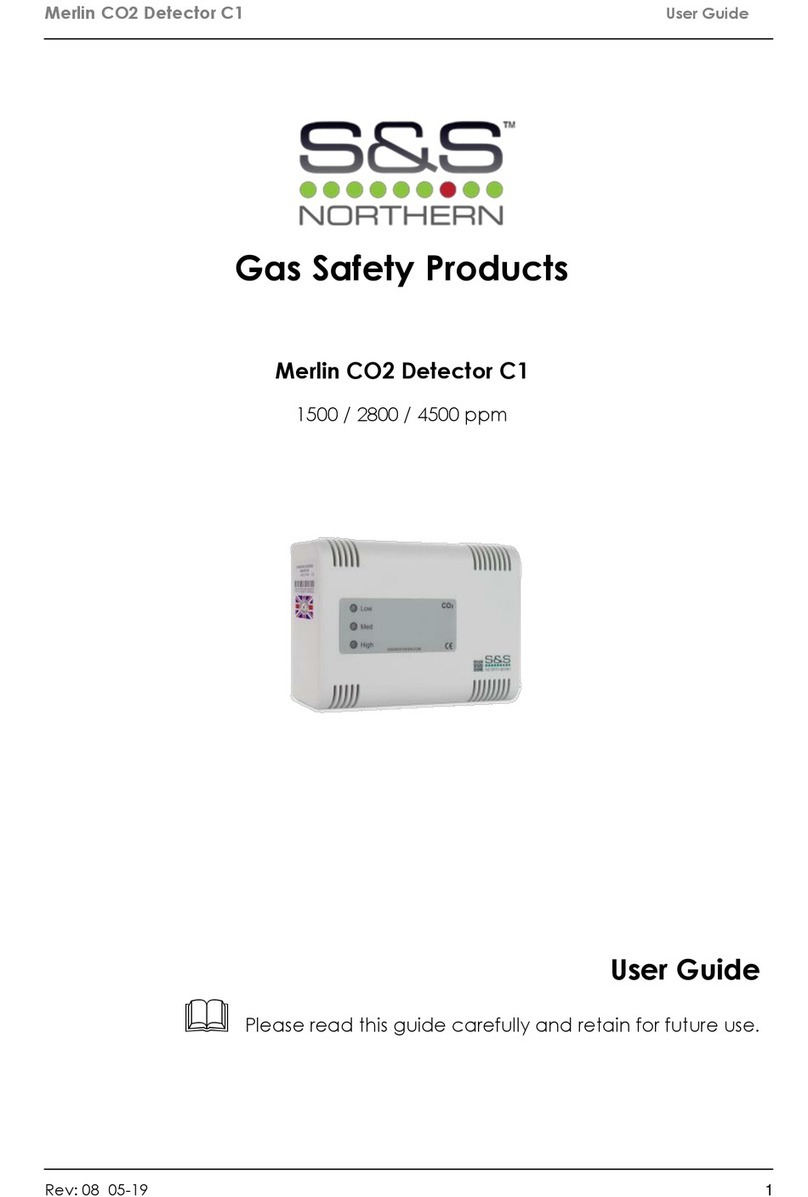
S&S Northern
S&S Northern Merlin 1500ppm User manual

S&S Northern
S&S Northern Merlin GDP4 User manual
